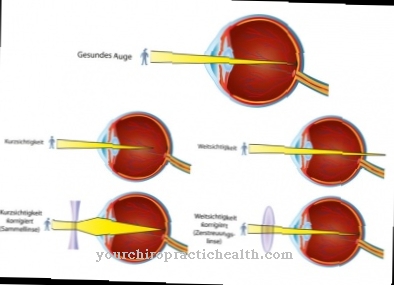Under one Suction bell birth is understood as a vaginal-operative method of delivery. It is used for birth complications.
What is a suction bell birth?
The Suction bell birth also bears the designations Suction bell delivery or Vacuum extraction. What is meant is a vaginal surgical procedure that is part of obstetrics. No other method in the world is used as frequently as the suction cup birth. With the help of a suction cup delivery, the birth of the child can be effectively supported.
The last part of the labor, which doctors call the expulsion period, is particularly stressful for the infant. The blood flow to the placenta and uterus deteriorates during the contractions. As a result, an acute oxygen deficiency in the child can occur. In medicine there is talk of hypoxia, which can be recognized by changing the heart rate.
In addition, there is extensive pressure on the child's head. This in turn threatens to reduce blood flow to the brain. It depends on the baby's physical reserves whether it can cope with this severe stress or whether complications arise. This includes, for example, slowing down the heart rate.
In order to accelerate the birth of the child in such cases, it is possible to use a suction cup. In Germany alone, five percent of all births are carried out with a suction cup every year. A distinction must be made between the conventional suction bell and the kiwi suction bell. The latter is one of the disposable suction bells and, unlike the conventional suction bell, does not have an electric motor.
Instead, it is equipped with a handle that the doctor can use to generate negative pressure. Overall, the use of a kiwi suction cup is seen as being gentler on the child. However, both versions are considered to be easy to use. Basically, with consideration for the child, a suction bell delivery is preferable to a forceps delivery. The material of the suction bell consists of silicone, rubber, plastic or metal. The size of the aid is between 40 and 60 millimeters.
Conditions for a suction bell birth
Several conditions must be met in order for a suction cup delivery to take place. For example, the child has to assume a position in the skull and its small head must be in the middle of the maternal pelvis. It is also important that the amniotic sac and the cervix open up.
Before performing the suction cup delivery, the doctor should also ensure that there is no imbalance between the birth canal and the baby's head. Because a full urinary bladder in pregnant women can have a detrimental effect on childbirth using a suction cup, it must be emptied before the birth process begins. The mother also needs appropriate anesthesia, such as epidural anesthesia (PDA).
What happens during a suction cup delivery?
During a suction bell delivery, the baby's head is pulled out of the pregnant woman's birth canal with the vacuum bell. In this way, the birth process can be accelerated. The mother's bladder is emptied with a catheter. After the anesthetic is administered, the doctor will make a perineal incision while the mother is in the delivery bed.
She rests her legs on special leg holders. Before the doctor begins the procedure, he will once again check the cervix and the position of the child. Finally, the suction cup is inserted into the vagina. Then the doctor attaches the instrument to the back of the child's head. He uses buttons to determine the correct position of the bell and whether the mother's soft tissues are still intact.
A hose is used to connect the suction bell to a pump. This is used to pump out the air between the child's head and the vacuum bell and in this way to enable negative pressure. If the next contraction occurs and the mother strains, the doctor gently pulls on the suction cup and in this way takes the baby out of the birth canal. If the child's head is outdoors, the vacuum bell is carefully removed. The birth process then takes its normal course.
What does a suction cup birth mean for your baby?
The suction bell birth is often noticeable in the baby. There is usually a round swollen area on the back of the child's head. However, this is considered harmless and goes back by itself after a few days.
However, performing a suction cup delivery involves certain risks for the child. If, for example, the pressure changes too quickly when applying or removing the vacuum bell, or if it is released during the birth process, there is a risk that the child's scalp will be affected. This, in turn, can damage the scalp or even cause dangerous bleeding into the brain.
It is also conceivable that the mother may also suffer injuries during a suction cup delivery. For example, there is a risk of tears in the cervix or enlargement of the perineal incision wound. Under no circumstances should vacuum extraction be performed if the baby is premature. There is an increased risk of cerebral haemorrhage in the child.
Benefits of a suction cup delivery
Childbirth with a suction cup has several advantages for both mother and child. The procedure has less risk of injury than forceps delivery. In the event of birth complications or exhaustion of the mother, the birth can be accelerated considerably by using the suction cup procedure. In this way, possible harm to the baby from a lack of oxygen can be avoided. In addition, missing adjustments of the child's head to the pelvis can be made more easily.

.jpg)






















.jpg)



